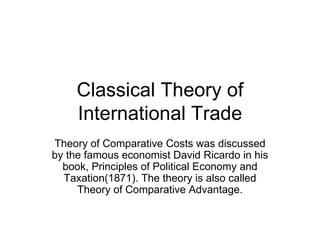Classical Theory Of International Trade
- 1. Classical Theory of International Trade Theory of Comparative Costs was discussed by the famous economist David Ricardo in his book, Principles of Political Economy and Taxation(1871). The theory is also called Theory of Comparative Advantage.
- 2. Meaning According to this theory every country should specialize in production. It should export those goods in which it has greater comparative advantage and import those goods in the production which it has greater comparative disadvantage. In response to the first question relating to international trade Ricardo stated that comparative costs theory tells us why does international trade take place. On the contrary J.S.Mill stated that terms of trade or prices were determined by the principle of reciprocal demand.
- 3. Assumptions Theory of comparative costs is based on the following assumptions : There are only two countries and they produce two goods. Labour is the only factor of production and cost of production is measured in terms of labour units. All units of labour are homogeneous. Production is subject to law of constant returns. Factors of production are perfectly mobile within the country but are perfectly immobile between two countries. There is full employment in countries concerned.
- 4. Basis of International Trade 1. Absolute Difference in Costs 2.Comparative Difference in Costs. 3. Equal Difference in Costs.
- 5. Absolute Difference in Costs According to Adam Smith, the main basis of international trade is the difference in absolute costs. This difference in absolute costs arises when one country is in a position to produce a commodity at a very low cost compared to the first country.
- 6. Absolute Difference in Costs (One dayŌĆÖs production of one Lab.) +2 +2 8 8 6 6 Total -2 +4 0 8 2 4 Nepal +4 -2 8 0 4 2 India Wheat Rice Wheat Rice Wheat Rice Country Change in production Production after Int. trade Production before trade
- 7. Comparative Difference in Costs According to Ricardo, comparative difference in costs is the sole cause of international trade. Comparative difference in costs means that a country is in a position to produce both the goods at less cost than the other country, yet it has greater comparative advantage in the production of other good.
- 8. Comparative Difference in Costs (One dayŌĆÖs production of one Lab.) -2 +6 16 20 18 14 Total +8 -4 16 0 8 4 Nepal -10 +10 0 20 10 10 India Country Wheat Rice Wheat Rice Wheat Rice Change in production Production after Int. trade Production before trade
- 9. Equal Difference in Costs When the production ration of two goods in two countries is equal, it is called equal difference in costs. In this situation, IT will not be possible.
- 10. Equal Difference in Costs 6 3 Nepal 8 4 India Wheat Rice Country
- 11. Criticism Only a normative theory- It does explain as to how economic welfare can be promoted as a result of international trade and how the resources of the country can be put to optimum use. But it fails to explain the composition of international trade or the nature of exports and imports and what are their problems. Based on labour theory of value- other factors are ignored. Based on the law of constant return










